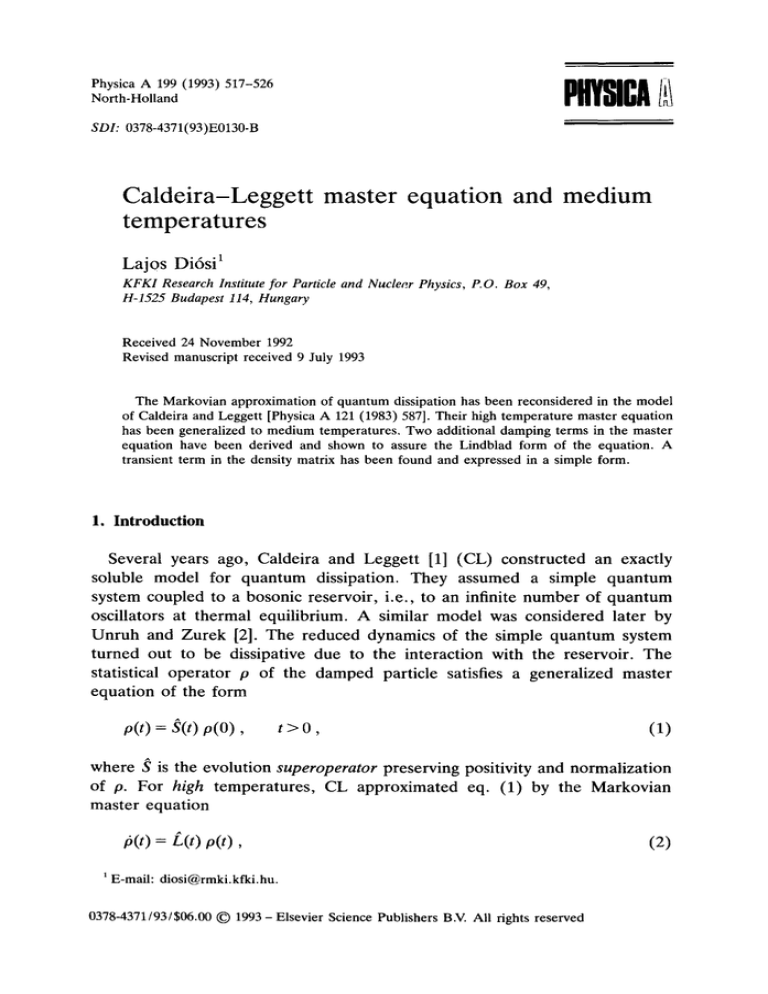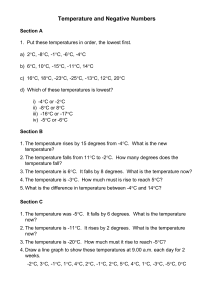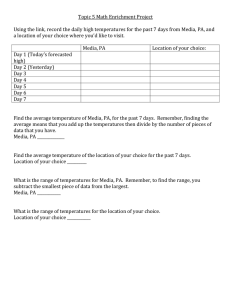
North-HollandPhysica
A 199 (1993)517-526
P ~ g l
[~
SDI: 0378-4371(93)E0130-B
Caldeira-Leggett master equation and medium
temperatures
Lajos Di6si 1
KFKI Research Institute for Particle and Nuclear Physics, P.O. Box 49,
H-1525 Budapest 114, Hungary
Received 24 November 1992
Revised manuscript received 9 July 1993
The Markovian approximation of quantum dissipation has been reconsidered in the model
of Caldeira and Leggett [Physica A 121 (1983) 587]. Their high temperature master equation
has been generalized to medium temperatures, Two additional damping terms in the master
equation have been derived and shown to assure the Lindblad form of the equation. A
transient term in the density matrix has been found and expressed in a simple form.
1. Introduction
Several years ago, Caldeira and Leggett [1] (CL) constructed an exactly
soluble model for q u a n t u m dissipation. They assumed a simple q u a n t u m
system coupled to a bosonic reservoir, i.e., to an infinite n u m b e r of q u a n t u m
oscillators at thermal equilibrium. A similar model was considered later by
U n r u h and Z u r e k [2]. The reduced dynamics of the simple q u a n t u m system
turned out to be dissipative due to the interaction with the reservoir. T h e
statistical o p e r a t o r p of the d a m p e d particle satisfies a generalized m a s t e r
equation of the form
p(t) = S(t) p ( 0 ) ,
t > 0,
(1)
where S is the evolution superoperator preserving positivity and normalization
of p. For high temperatures, CL approximated eq. (1) by the M a r k o v i a n
master equation
IJ(t) = L ( t ) p(t) ,
1E-mail: diosi@rmki.kfki.hu.
0378-4371/93/$06.00 t~) 1993- Elsevier Science Publishers B.V. All rights reserved
(2)
518
L. Di6si / Caldeira-Leggett master equation and medium temperatures
where L is the Liouville superoperator, also given by CL.
In our paper, we try to generalize the Markovian approximation for m e d i u m
temperatures, too. We recalculate the Liouville operator L from the exact CL
evolution operator S. Our result differs from CL's one by additional damping
terms known from Dekker's earlier phenomenological calculations [3]. Our L
is of the Lindblad [4,5] form, which assures its mathematical consistency,
while, on the other hand, the CL master equation would violate the positivity
of the statistical operator p, see refs. [6,7].
2. The generalized master equation
Assume a certain quantum particle with Heisenberg canonical operators q(t)
and p(t). For concreteness, we think of a quantum oscillator, so that canonical
equations are the following:
Cl = ( 1 / M ) p ,
p = -Mo)2q .
(3)
The quantum state will be represented by the statistical operator p.
Consider, on the other hand, a certain bosonic reservoir and single out a
certain harmonic coordinate Q(t) of it. Let us introduce the auto-correlation
function of Q(t),
1
(4)
a(t) = ~ (Q(t) Q(0)) T,
where symbols ( . . . ) r stand for equilibrium expectation values at temperature
T.
At t = 0, let us couple the reservoir and the particle together, by switching
on the interaction Hamiltonian
H I = qQ.
(5)
Having solved the coupled dynamic equations and then having traced over
reservoir states, one obtains a generalized master equation of the form (1). If
at t = 0 the particle and the reservoir were uncorrelated (to the opposite case
see, e.g., ref. [8]) then the evolution superoperator S is given the following
exact form:
Ilii
S(t) : 1" exp - ~
d~-
o
ds (i[q+(z) - q_('r)]oti('r - s) [q+(s) + q_(s)]
o
+ [q+ (~'1 - q_ ('r)]O~R(7"- - S) [q+ (S) -- q_(s)]}),
(6)
L. Di6si / Caldeira-Leggett master equation and medium temperatures
519
where O~R,a I are the real and imaginary parts, respectively, of the correlation
function (4). Now is the time to explain the superoperator notation applied
above. A usual operator, say q, becomes superoperator when it is appended by
a + / - index, indicating q is to be applied to the statistical operator p from the
left/right, respectively. Furthermore, symbol J~ prescribes time-ordering for
q+(t) while anti-time-ordering for q_(t), cf. ref. [9].
In their pioneering work [1] CL derived and presented formula (6) in
path-integral formalism (see their equation (3.9)), which is equivalent to our
T-product formalism. For brevity, we introduce the standard notations [9]
qA=q+--q_,
q¢
~(q+ +q--)'
(7)
hence eq. (6) reads
(lii
S(t) = T exp - ~
dr
0
ds [2iqa(, ) a,(~" - s) q~(s)
0
+ q~(r) aR(, -- S) q~(s)l) •
(8)
The CL model of reservoir and the choice of coupling led to the following
correlation functions (cf. eqs. (3.10), (3.11) and (3.23) of ref. [1]):
/2
aR(~-) = 77 f to coth (hto/2kT) cos(to~') dto
Ti"
(9a)
0
0
Oti (,./.)
= - - n-
'IT
f
0
to sin (tot) dto
(9b)
where the coupling constant ~7 plays the role of viscosity coefficient, the cutoff
12 is the maximum frequency of reservoir oscillators.
Eq. (6), applied to eq. (1), gives the exact solution for the dynamics of the
quantum particle's damped motion. Remember that q±(~-), q+_(s) are the
solutions of the particle Heisenberg equations of motion (3).
3. Markovian approximation, medium and high temperatures
From now on, we consider high and medium temperatures satisfying the
condition
k T >~hi2.
(10)
520
L. Di6si / Caldeira-Leggett master equation and medium temperatures
It is rather straightforward to see that the correlation function (4) falls for large
time separations,
if I~-I > ~-c.
a(~-) ~ 0
(11)
For the CL reservoir (9a,b), the characteristic time of the memory ~'c of the
reservoir can be chosen as
= l/O,
(12)
provided condition (10) is fulfilled.
To prepare the Markovian approximation, write the correlation functions
(9a,b) in the following forms:
271kT g(T)
O~R('/') = T
--
~T
O/I(T) = "0g'("/') ,
g"(T) + . . . .
(13a)
(13b)
where the ellipse stands for the third (and higher) powers of the inverse
temperature 1/T times the fourth (and higher) time derivatives of the function
g. This latter is defined by
g(~.) _---__1 f dto cos(to~')
T~
(14)
i.e. it is a smoothed delta-function of a width of about ~'c = 1/O and of height
g(0) = O/'rr.
(15)
(The expansion (13a) has its counterpart in eq. (3.19) of ref. [1].)
We are now prepared to summarize the concrete rules of the Markovian
approximation, which will be applied in the forthcoming section. (i) Following
ref. [1], we take g(z)~6(T) but, whenever g(0) enters explicitly, we shall
retain its regularized value (15). (ii) Opposite to ref. [1], we shall retain the
first two terms on the rhs of eq. (13a) and then neglect the higher order ones.
Step (i) assumes that non-stationary features of the particle dynamics, if finer
than the reservoir memory %, will not be described. This approximation is still
useful provided
to ~ 1/re,
i.e. the
dynamic acceleration
(16a)
(cf. eq. (3)) of the damped particle is small at the
L. Di6si / Caldeira-Leggettmaster equation and medium temperatures
521
time scale of the reservoir's memory. A similar condition must be satisfied for
the frictional deceleration. The corresponding mathematical condition is
7~/2M~1/~
(16b)
though this fact can only be justified later, in section 4.
In brief, we point out that the fulfillment of condition (16a) justifies step (ii)
as well. It can be shown that the neglected higher order terms in eq. (13a) are
proportional to increasing powers of the ratio to/T. The smallness of these
terms is assured by condition (16a) combined with condition (10).
4. Calculation of the Liouville operator and the initial slip
We are going to calculate the Markovian approximation of the exact
evolution superoperator S(t). Let us write eq. (8) into the form
S(t) = Texp[~(t)]
(17)
and assume the time lapse is much greater than the reservoir memory:
t>>%--- l/g2.
(18)
We have to calculate the superoperator 2~(t), i.e. the double integral on the rhs
of eq. (8). We substitute eqs. (13a) and (13b) into it. Then we apply the
Markovian approximation explained in the preceding section.
The first term contributes as
l
~(~)(t)--
T
2vkT
h2 f dr f ds qa(r) g('r - s) qa(s)
0
i
h2
0
(19)
dr [qa(r)] 2
0
The second term yields
l
'r
= 6---k--T dr
0
n
"~ 6--~
ds qA(r) g"(T --S) qa(s)
0
dr qa(r) (la(r)--~
--~-[qA(O)] - - ~r
0
dr [qa(r)] 2 ,
0
(20)
522
L. Di6si / Caldeira-Leggett master equation and medium temperatures
where we have ignored a term ( ~ / 6 k T ) [qaqa]o."
' Its contribution is small as
compared to the second integral on the rhs, due to condition (18).
The imaginary part (13b) yields the following contribution:
~ll)(t) ~- -2-h-
dr
0
ds qA(Z) g'(T--S) qc(S)
0
(21)
0
0
At the conditions of Markovian approximation (cf., in particular, conditions
(10) and (16a)) one has thus obtained the following result:
~(t) = . ~ ) ( t ) + .~ ~)(t) + i~(~l)(t),
t>>.rc .
(22)
The main advantage we have achieved is that double time-integrals representing the exact form of ~(t) have been approximated by single integrals.
Consequently, we can use the following ansatz:
~(t) ~ ~tr -I- i dT L(T),
0
t >>~'c,
(23)
where ~tr is a certain transient term, and L is the Liouville superoperator, as
we shall see below. But first, let us concretize their forms. By comparing eq.
(23) with eqs. (19)-(22), we get the transient term ~tr in the form
2tr = - 6 k T [q+ (0) - q_ (0)] 2 .
(24)
The Liouville superoperator takes the Dekker form [3]
i
L = --~(n~
i
-H')--~y(q+
-q_)(p+
+p_)
1
h2 [Dpp( q + - q_)2 + D qq(p + _ p _ ) 2 + 2Dpq( q + - q_ ) ( p + - p _ ) ] ,
(25)
where, for brevity, we have suppressed notations of time arguments in /,(t),
q(t) and p(t). The latter stands, of course, for q(t) times the mass M.
The reservoir has renormalized the particle Hamiltonian by adding the
inverse harmonic oscillator potential [1] to it,
L. Di6si / Caldeira-Leggett master equation and medium temperatures
H'
=
-
~/__~O q2.
523
(26a)
'It
The four damping constants of Dekker's phenomenology turn out to take the
following values:
"
Y=2M
'
(26b)
Dpp =~kT,
(26c)
~Th2
Dqq- 12M2kT,
(26d)
,0.Oh 2
(26e)
D p q - 12arMkT"
(Eqs. (26a,b) correspond to ref. [1], eqs. (3.37), (3.36), respectively, while the
coefficient (26c) appears first in eq. (5.1) of ref. [1].)
It remains to interpret the transient t e r m .a~trand to prove that L of eq. (23)
plays the role of a Liouville operator indeed. Let us substitute eq. (23) into eq.
(17):
¢S(t)~-(Texp i d~"L(~'))exp(.~tr) ,
t>>%.
(27)
o
It is worthwhile to recall the effect of T-ordering: the transient factor gets to
the very right. Invoking the generalized master equation (1), we are going to
interpret the effect of the evolution superoperator (27). The coupling to the
reservoir at t = 0 changes the quantum state of the particle after a transient
period t -~ %:
p(0)----~ exp(,~tr) f l ( 0 ) ~ e x p ( - 6 - ~ T [ q +(0) - q_ (0)] 2) p(0).
(28)
In the spirit of the recent paper by Suarez et al. [10], this initial slippage
destroys non-Markovian non-stationary features built in the initial state. After
this transient period the statistical operator satisfies the stationary Markovian
master equation (2) with the Liouville superoperator (25):
524
L. Didsi / Caldeira-Leggett master equation and medium temperatures
i
i
t5 = Lp ~ --~[H', p] -~3"[q, {p, p}]
1
hE (Dpp[q, [q, p]] + Dqq[p, [p, p]] + 2Dqp[q, [p, p]]).
(29)
Hence, the main result of the paper has been presented by eqs. (28), (29)
together with eqs. (26a-e). In particular, the master equation (29) is expected
to be valid for medium and high temperatures (10), and for small dynamic and
frictional accelerations. Consider the quantum expectation value v =-tr(pp)/M
of the velocity. The master equation (29) together with the Heisenberg
equation (3) lead to the well-known classical equation of motion
2
O = - - ( D R q --
23"v,
(30)
where w~=(D2-4yl2/~r (cf. eq. (3.37) of ref. [1]). Thus the dynamic
acceleration is characterized by the renormalized frequency [1] (DR, while the
frictional deceleration is characterized by the relaxation constant 3'. In summary, the master equation (29) is valid for
(DR, 3' ~ ~-~ ~
kT/h,
(31)
although we cannot exclude the possibility that further restrictions are necessary.
5. Discussion
Master equation must preserve normalization and positivity of the statistical
operator. If the 2 × 2 matrix of Dekker's coefficients is positive, i.e.
Dqq
Dqp + ½ihT~
Dqp - ½ihy
Opp ] > O,
(32)
then the master equation (29) belongs to the Lindblad class [4,5], which
guarantees mathematical consistency including positivity of the statistical
operator p.
~(1) depending on q, the only
Had we ignored in section 4 the terms "-~R,I
nonzero coefficient would be Dpp. This is the simplest Markovian approximation. It yields a mathematically consistent master equation which, however,
does not take into account energy dissipation. The CL master equation [1]
L. Di6si / Caldeira-Leggett master equation and medium temperatures
525
~(1)
ignores ~R(1) while it retains ,,~ . It describes dissipation but it violates the
positivity condition (32) because Dpp = 0 (and Dqp = 0 ) in it while 3' ~ 0.
Let us turn back to our master equation (29) with the complete set (26a-e)
of nonvanishing Dekker coefficients. Let us calculate the determinant of the
matrix (32):
DppDqq - DZpq - h 2 y 2 / 4 = c o n s t . x
[ 1 - ~ w1 2 k(h/~'~
21
kT / J "
(33)
It is definitely positive in the medium and high temperature regime (10) and,
therefore, our master equation (29) belongs to the Lindblad class.
What can be done with initial slippage (28). Let us write it in coordinate
representation,
x-y
2
(34)
where
(35)
The transient process (34) performs a fast diagonalization of the particle
density operator, in accordance with the results of Hu et al. [11]. In the high
temperature limit kT>>hO, the initial slip (28), (34) can be ignored as
compared with the similar and quicker effect of the term Dpp[q, [q, p]] in the
master equation (29). This is completely in agreement with the result of Hu et
al., who have observed the absence of the initial jolt in the exact time
dependent coefficient Dpp in the high temperature limit.
Presumably the coherence length, i.e. the characteristic length scale at which
(xlply) is "diagonal", will never be increased by the stationary process (29)
either. Hence O'm,x (35) is an absolute bound, valid at any not too low
temperature (i.e. when T >~hl2/k) for the coherent extension of the particle.
6. Outlook
Very recently, stochastic wave function models have been proposed to
describe the evolution of various damped quantum systems (see e.g. ref [12]).
The new model is physically equivalent to the master equation, advantageous
in numeric simulations and represents a concurrent tool to the Wigner
functions in investigating the quantum-classical correspondence. Theoretical
526
L. Di6si / Caldeira-Leggett master equation and medium temperatures
g r o u n d s of the new m e t h o d have already b e e n k n o w n earlier. E v e r y M a r k o vian m a s t e r e q u a t i o n allows us a u n i q u e j u m p [13] or, alternatively, a u n i q u e
Gaussian process [14] to use for describing the evolution o f the w a v e function,
p r o v i d e d the m a s t e r e q u a t i o n is o f L i n d b l a d type. T h e L i n d b l a d m a s t e r
e q u a t i o n of the C L m o d e l (first published in ref. [7]) o p e n s the w a y to
construct the c o r r e s p o n d i n g stochastic wave function e q u a t i o n and to grasp the
fruits of the q u a n t u m state d i f f u s i o n [15] m e t h o d .
Acknowledgement
This w o r k was partly s u p p o r t e d by the H u n g a r i a n Scientific R e s e a r c h F u n d
u n d e r G r a n t No. 1822/1991.
References
[1]
[2]
[3]
[4]
[5]
[6]
[7]
[8]
[9]
A.O. Caldeira and A.J. Leggett, Physica A 121 (1983) 587.
W.G. Unruh and W.H. Zurek, Phys. Rev. D 40 (1989) 1071.
H. Dekker, Phys. Rep. 80 (1981) 1.
G. Lindblad, Cornmun. Math. Phys. 48 (1976) 119.
H. Dekker and M.C. Valsakumar, Phys. Lett. A 104 (1984) 67.
V. Ambegaokar, Bet. Bunsenges. Phys. Chem. 95 (1991) 400.
L. Di6si, report KFKI-1992-04/E; Europhys. Lett. 22 (1993) 1.
V. Hakim and V. Ambegaokar, Phys. Rev. A 32 (1985) 423.
K. Chou, Z. Su, B. Hao and L. Yu, Phys. Rep. 118 (1985) 1;
L. Di6si, Phys. Rev. A 42 (1990) 5086.
[10] A. Suarez et al., J. Chem. Phys. 97 (1992) 5101.
[11] B.L. Hu, J.P. Paz and Y. Zhang, Phys. Rev. D 45 (1992) 2843.
[12] J. Dalibard, Y. Castin and K. Molmer, Phys. Rev. Lett. 68 (1992) 580;
C.W. Gardiner, A.S. Parkins and P. Zoller, Phys. Rev. A 46 (1992) 4363.
[13] L. Di6si, Phys. Lett. A 114 (1986) 451.
[14] N. Gisin, Helv. Phys. Acta 62 (1989) 363.
[15] N. Gisin and I.C. Percival, J. Phys. A 25 (1992) 5677.



